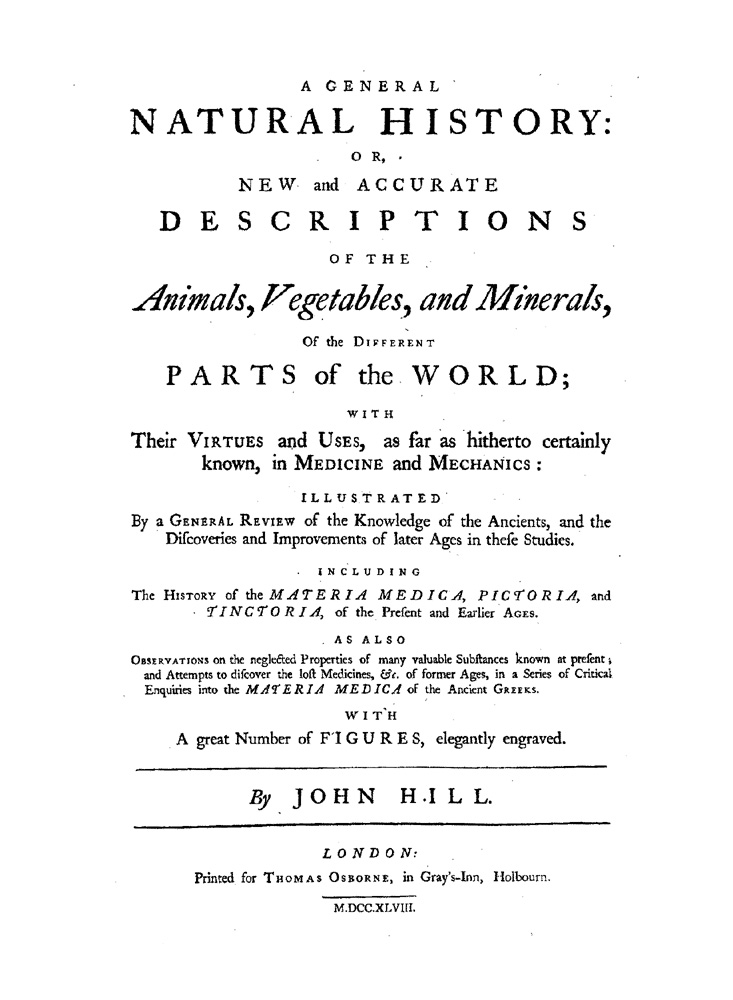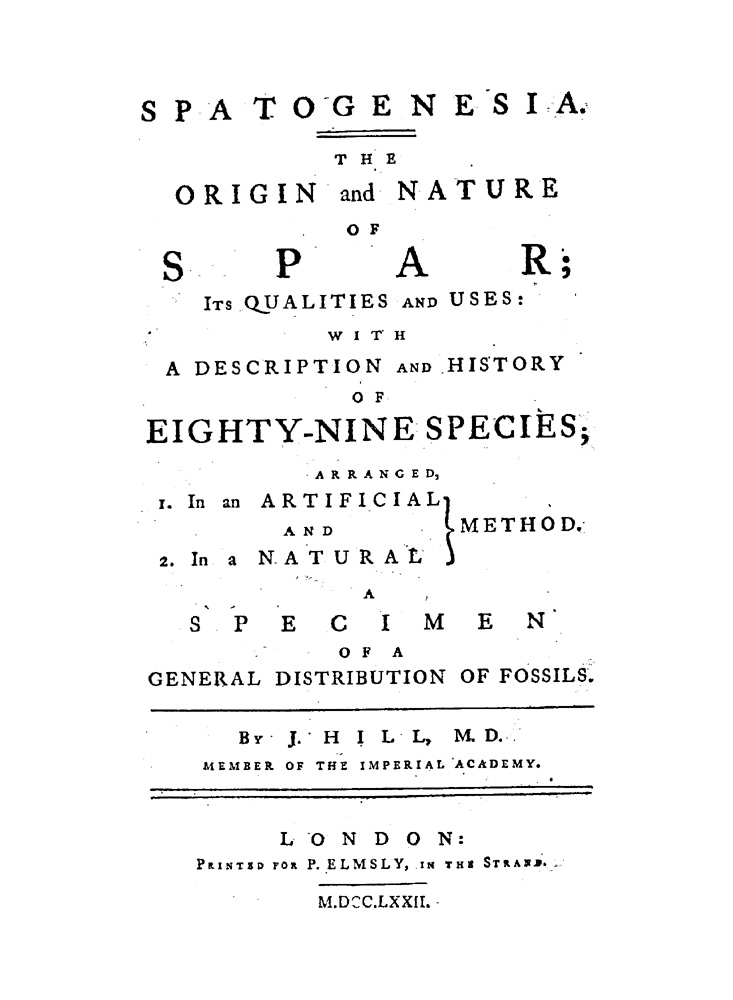HILL, John.
(1707 – 1775)
Hill calling himself "Sir John" on account of his knighthood in the Swedish order of Vasa flourished as an apothecary and quack doctor in James Street, Covent Garden. He conducted the British Magazine from 1746 to 1750 and contributed articles to various other periodicals. He vigorously attacked the Royal Society, which steadfastly ignored Hill's scientific contributions. He was a prolific author of compilations and translations dealing with medicine, botany, horticulture and natural history. His most celebrated contribution was The Vegetable System (London, 1759-75).
Biographical references: BBA: I 552, 245-311; 1231, 20-21. • Catalogue of Portraits of Naturalists: 578 [3 portraits listed]. • DNB: 9, 848-52 [by G.F.R. Barker]. • Drugulin, Sechstausend Portraits, 1863: nos. 2478-9. • DSB: 6, 400-1 [by P.A. Gerstner]. • ISIS, 1913-65: 1, 571. • Lambrecht & Quenstedt, Catalogus, 1938: 201. • Poggendorff: 1, col. 1104. • Rousseau, G.S., A literary quack of London: a life of Sir John Hill. ??, ??. • Rousseau, G.S., "The much-maligned doctor, `Sir' John Hill (1707-1775)", Journal of the American Medical Association, 212, (1970), 103-8. • Sarjeant, Geologists, 1980: 2, 1259, Suppl. 1 (1985), 1, 493-4 & Suppl. 2 (1995), 1, 724. • WBI. • Woodruff, L.L., "The versatile Sir John Hill, M.D.", American Naturalist, 60, (1926), 417-42.

1. English, 1748 [First edition].
A General | Natural History: | or, | New and Accurate | Descriptions | of the | Animals, Vegtables, and Minerals, | of the Different | Parts of the World; | with | Their Virtues and Uses, as far as hitherto certainly | known, inMedicine and Mechanics: | Illustrated | By a General Review of the Knowledge of the Ancients, and the | Discoveries and Improvements of later Ages in these Studies. | Including | The History of the Materia Medica, Pictoria, and | Tinctoria, of the Present and Earlier Ages. | As also | Observations on the neglected Properties of many valuable Substances known at present; | and Attempts to discover the lost Medicines, &c. | of former Ages, in a Series of Critical | Enquires into the Materia Medica of the Ancient Greeks. | With | a great Number of Figures, elegantly engraved. | [rule] | By John Hill. | [rule] | London: | Printed for Thomas Osborne, in Gray's-Inn, Holbourn. | [rule] | M.DCC.XLVIII.
2°: π2 A2 a2 B-Z2 2A-2Z2 3A-3M2 4O-4Z2 5A-5Z2 6A-6Z2 7A-7I2 26A-26Z2 27A-27Z2 8A-8E2; 352l.; [12], 1-228, 333-592, 457-654, [6] p., folding table (facing page 1), 12 engraved plates. Pages 457 to 592 are repeated in the sequence. Page size: 358 x 228 mm.
Contents: [2 pgs], Half title page, "[rule] | A | History | of | Fossils. | By John Hill. | [rule]," verso blank.; [2 pgs], Title page, verso "Contents of the Volumes. | ..."; [2 pgs], Dedication to Doctor Shaw, signed John Hill.; [6 pgs], "The Preface."; Folding table.; 1-422, "The | History | Of | Fossils. | Part the First. | ... | Fossils naturally and essentially simple, not inflammable, nor soluble in water."; 423-592, 457-621, "The | History | Of | Fossils. | Part the Second. | ... | Fossils naturally and essentially compound, not inflammable nor soluble in water."; 622-637, "The | History | Of | Fossils. | Part the Third. | ... | Metallic Fossils."; 638-654, "Appendix | To The | History Of Fossils. | Of animal and vegetable substances bury'd in the earth."; [6 pgs], "Index."
Plates: All the plates of the volume have an included description and each shows minerals, crystals or fossils. All plates except the first are signed B. Cole Sculp. The table and plates of the volume comprise: Folding table, p. 1, "Table of Fossils." Plate I, p. 110, "Talcs and Fibrariæ" (14 figs.). Pl. 2, p. 152, "Selenitæ" (19 figs.). Pl. 3, p. 200, "Crystals" (48 figs.). Pl. 4, p. 544, "Siderochita" (23 figs.). Pl. 5, p. 621, "Pyritæ" (17 figs.). Pl. 6, p. 640, "Vegetable Bodies Immers'd In Stone" (14 figs.). Pl. 7, p. 642, "Fossile Corals" (17 figs.). Pl. 8, p. 644, "Fossile Teeth, Palates, Vertebræ & Whole Fish" (+40 figs.). Pl. 9, p. 646, "Fossile Shells" (27 figs.). Pl. 10, p. 648, "Fossile Shells" (+40 figs.). Pl. 11, p. 650, "Fossile Shells" (+40 figs.). Pl. 12, p. 654, "Fossile Bodies, Once Parts of Animals" (+40 figs.).
Very scarce. This is the first volume of Hill's three volume treatise, A General Natural History, which described nature's three realms, i.e., mineral, plant and animal. In the present work, A History of Fossils, minerals are divided into series, classes, orders, genra and the analog of species. They are then described according to their behavior in fire and acid, their cleavage or lack thereof, their surface texture, and their appearance under the microscope. An interesting feature of the book arises from the odd naming of the various species. Hill invented a unique nomenclature that took a mineral's distinguishing properties, and recast them into their Greek equivilents to form descriptive polysyllabic names, which is very useful if one is conversent in Greek. Unfortunately, even in Hill's time, the lay public and probably most of the scientific community were ignorant of the language, and therefore of the author's innovation. As a consequence, the valuable contributions this work made to microscopic mineral examination and to descriptive mineralogy in general had less impact on the science then they deserved.
Occasionally, a very rare copy of Hill's History of Fossils is found with the plates hand-colored. A note on the back of volume three's title page states, "There are a small number printed for the curious on Royal Paper; and the cuts of these are colored under the immediate inspection of the author." Exercise caution, however, when examining such copies because the plates may not have been originally colored. Sometimes the "faked" volumes can be recognized due to the whimsical colorings of the figures, but normally comparision with an authenticated copy is necessary.
Bibliographical references: Freeman, Natural Science Books in English, 19??: no. 1672. • Freilich Sale Catalog: no. 249. • Henrey, British Botanical Literature, 1975: no. 809. • Hoover Collection: no. 421.
2. English, 1773 [3rd edition].
A General Natural History: or, new and accurate descriptions of the animals, vegtables, and minerals of the different parts of the world; with their virtues and uses, as far as hitherto certainly known, in medicine and mechanics... By John Hill ... London, 1773.
8°:
Very scarce. Third edition. [Does this edition have a mineralogy volume?]
Bibliographical references: Burke, Origins of the Science of Crystals, 1966: 26. • Cobres, Deliciæ Cobresianæ, 1782: 2, 745-35. • DSB: 6, 400-401 [by P.A. Gerstner]. • Kobell, Geschichte der Mineralogie, 1864: 76-77. • Lambrecht & Quenstedt, Catalogus, 1938: p. 74. • LKG: XII 31 & 32. • Porter, Making of Geology, 1980: 100.
3. German, 1766 [German transl.].
History of Fossils translated by C.F.G. Westfeld. Gothaburg, 1766.
8°:
Very scarce. Not in NUC.
Bibliographical references: Berlinische Sammlungen: 3, ??. • LKG: XII 32.

4. English, 1771.
Fossils | Arranged | according to their | Obvious Characters; | with their | History and Description; | under the Articles of | [In two columns, separated by a double verticle rule:] Form, | Hardness, | Weight, [double verticle rule] Surface, | Color, and | Qualities; | The Place of their Production, | Their Uses, | and | Distinctive English, and Classical Latin Names. | [rule] | By J. Hill, M.D. | Member of the Imperial Academy. | [rule] | London: | Printed for R. Baldwin, in Pater-noster Row; | and P. Elmsly, in the Strand. | [rule] | M.DCC.LXXI.
8°: [A]-F4 G2 H-Q4 R8 S-Z8 2A-2Z4 3A-3H4 3I2; 220l.; [i]-viii, 9-51, 56-132, 133*-140*, 133-420, [16] p., one folding table (p. 122). Page size: 212 x 128 mm.
Contents: [i-ii], Title page, verso blank.; [iii]-viii, "Introduction."; 9-198, "Native Fossils."; 199-420, "Part II. Compound Fossils. Form'd by Mixture of Two, or more Native, Earthy Kinds."; [16 pgs], "Index."
Very scarce. One of the rarer of the author's many publications in which minerals and physical properties such as hardness, color, weight, surface texture and uses are arranged in a series of tables. The large folding diagram outlines the intricate system employed to distribute the minerals. The purpose was to lay down an arrangement of minerals and fossils founded upon their obvious characteristics, such as form, hardness, weight, surface, color, localities, use, without need of chemical experiments. Hill proposed using the outward qualities of a mineral exclusively, and these were determined by sight, smell, taste and touch. The text makes heavy use of tables to organize the characteristics of each species, and it is clear that Hill did not require all features to be defined for a given mineral. For example, sulfur is said to have a distinct odor. For each species, the author has provided synonyms to Wallerius, Bomare, Linneaus and his earlier History of Fossils (London, 1748). In this work, Hill anticipated Werner in the use of physical characters to distinguish between mineral species; however, his text is so convoluted and irregular that it is difficult to derive a true picture of the system Hill is proposing.
Bibliographical references: Dana's 7th (Bibliography): 73. • LKG: XII 33. • Sinkankas, Gemology Bibliography, 1993: no. 2944. • Ward & Carozzi, Geology Emerging, 1984: no. 1071.

5. English, 1772.
Spatogensia. | [double rule] | The | Origin and Nature | of | Spar; | Its Qualities and Uses: | with | A Description and History | of | Eighty-nine Species; | Arranged, I. In an Artifical | and | 2. In a Natural | [A "$\rbrace$" groups items I. & 2.] Method. | A Specimen | of a | General Distribution Of Fossils. | [rule] | By J. Hill, M.D. | Member of the Imperial Academy. | [double rule] | London: | Printed for P. Elmsy, in the Strand. | [rule] | M.DCC.LXXII.
8°: π1 B-I4; 33l.; [2], 1-63, [1] p., one large folding table. Page size: 210 x 115 mm.
Contents: [2 pgs], Title page, verso blank.; 1-3, "Of the Origin of Spar."; 4-63, "Native Fossils. Class III. Spar."; [1 pg], Conclusions.; [At end], Folding table showing the classification of spars.
Very rare. A reprint with slight modifications of the section dealing with spars from the author's Fossils Arranged According to their Obvious Characters (London, 1771). An abstracted French translation was published as: "Spatogensie, ou traité de la nature et de la formation du spath," (See: Journal de Physique 3 (1774), pp. 209-18).
Bibliographical references: LKG: IX 11.
6. English, 1774.
An idea of an artifical arrangement of fossils, according to unalterable characters, and superadded qualities. Also a natural method; according, to their ascent toward their greatest perfection. London, The Author, 1774.
8°: [2], 40 p.
Very rare. First separte edition. Originally this work appeared in Hill's translation of Theoprastus' De Lapidbus (1774).
Bibliographical references: LKG: XII 34.
7. English, 1774.
Observations on the new-discovered Swedish acid; and on the stone from which it is extracted. By John Hill ... London: Printed for the author, 1774.
8°: [2], 5-16 p.
Very rare. First edition. Describes the mineral fluorite and its derivative, fluoric acid. Carl Wilhelm Scheele had first discovered this acid in 1771 [?].
Bibliographical references: LKG: XIV 422.
8. English, 1785.
Enquiries into the Nature of a New Mineral Acid, discovered in Sweden, and of the Stone from which it is obtained. To which is annexed and idea of an artifical arrangement and of a natural method of fossils, with examples in theCrystals, Spars and Earths. London: T. Trueman, 1785.
8° Very rare.
Bibliographical references: Dawson's Pall-Mall, Bookseller: catalog entry.
Theophrastus's History of Stones. With an English Version, and Critical and Philosophical Notes ... (London, 1746, other editions).See under: Theophrastus.
Copyright © 1982-2006 by Curtis P. Schuh. All rights reserved. Updated: 8/13/2007 9:59:53 AM
